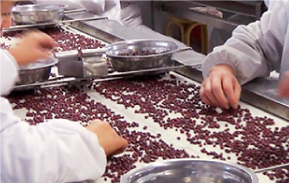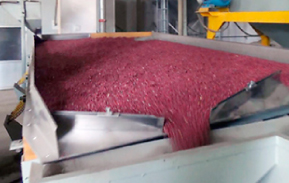Onsite Audits of Production Plants
We have our own safety standards at each production process
and regularly conduct onsite quality audits.
Onsite Quality Control at Production Plants
In order to guarantee safe and reliable food products for our customers, we run routine quality audits of our production plants during the product development phase.
The purpose of these audits is to verify whether each plant is compliant with our internal criteria which we have developed based on multiple inspections held at every stage of production process, including quality control of raw materials and sanitation management.
Additionally, even after launching our products in the market, we regularly inspect and audit our plants to monitor operational risks and to control associated issues.
Four rigorous quality control steps for producing Taiyaki (a Japanese fish-shaped cake)
Quality Control of Raw Materials
In order to maintain stable quality, we employ strict and consistent quality control standards, from incoming raw materials to the final products.
For instance, all the following steps must be complete before the raw materials of sweet red bean paste (an ingredient filled in Taiyaki) are converted into finished products:
Selection of Raw Materials
■Gravity Separator: Used for the removal of foreign substances such as stone, soil, and sand contained in raw materials
■Pneumatic Separator: Used for the removal of skins or hulls from red beans, cracked or broken beans, and any other defective beans
■Color Sorter: Used to detect and separate beans by their colors
■Visual Inspection:Conducted by a qualified inspector to separate various grades of product according to visual characteristics such as color, size and shape
■Inspection of Pesticide Residues in Food:Conducted to detect pesticide residues in food products in accordance with corresponding Japanese inspection standards and criteria

Quality Control in Production Plants
At our production plants, we have our own safety standards to ensure complete control over the quality and sanitation of food products according to each production process needs.
Sanitation Management
■Prevention of Foreign Contaminants in Food: Plant workers remove any residual dust from their work clothes with a lint roller.
■Air Shower: Used for the removal of unwanted hair, dust particles, etc. with high-velocity air blow jets
■Hand Washing and Disinfection: Plant workers thoroughly wash their hands with running water, and then disinfect their hands with alcohol-based hand sanitizers.
Quality Management
■Visual Inspection: Conducted by qualified inspectors to ensure quality standards are achieved
■Food Metal Detector: Used to detect metal impurities in food products

Quality Control of Final Products
All our final products are put through the following stringent quality testings at our in-house QC labs, so that we can provide safe and reliable products with the best taste and quality to our customers.
Sanitation Management
■ Microbiological Test: Conducted to verify that food quality is in compliance with applicable standards through microbiological testing of final products
■ Physical-chemical Test: Conducted to measure sweetness (sugar) levels and water content of a food product that may affect the food flavors
■ Texture Analysis: Conducted to measure the texture attributes such as hardness/softness of bean paste and dough of Taiyaki and to convert them into numerical values for data evaluation
Continuous Improvement of Quality Control Process
Even after the final products are ensured through product surveillance audit of production plants at the product development phase, we regularly inspect and audit our plants and review the corresponding records as needed in order to continuously improve our quality control process. As we move through this process, we are fully committed to delivering truly stable and high-quality food products. On top of that, we collect feedback from customers regarding our products, and constantly make improvements and enhancements to a higher quality product in close cooperation with our production plants.

